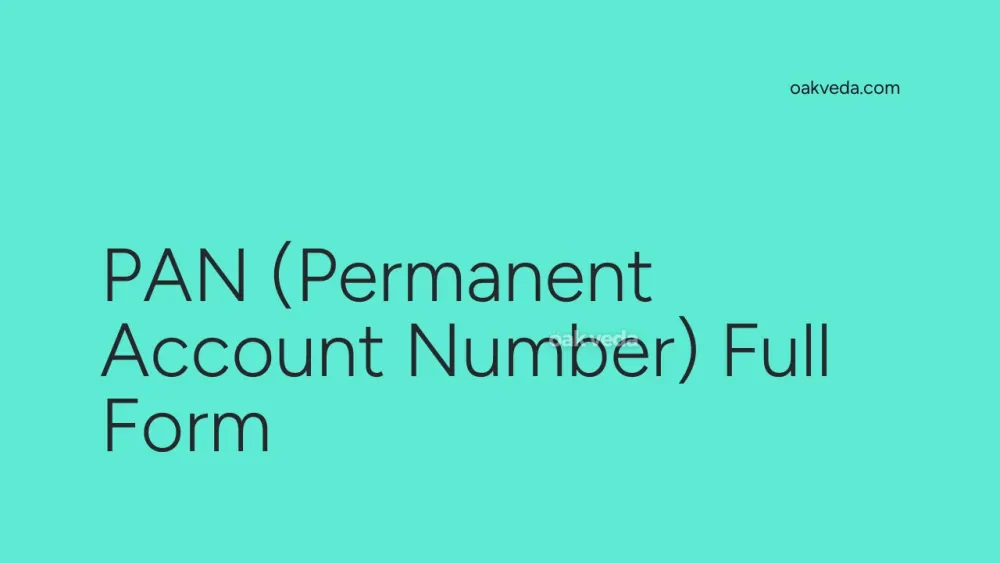
What is the Full Form of PAN?
PAN is the full form of Permanent Account Number. It is a unique 10-digit alphanumeric identifier issued by the Indian Income Tax Department to individuals, businesses, and other entities operating within India.
What is Permanent Account Number?
A Permanent Account Number (PAN) is a vital document that serves as a universal identification for all financial transactions in India. It is mandatory for various financial activities, including filing income tax returns, opening bank accounts, and conducting high-value transactions.
Origin and Development of Permanent Account Number
The concept of PAN was introduced in 1972 to combat tax evasion and create a unified system for tracking financial transactions. Over the years, it has evolved into an essential tool for financial governance and transparency in India.
How does Permanent Account Number work?
PAN works as a unique identifier that links all financial transactions of an individual or entity. When you provide your PAN for any financial activity, it allows the Income Tax Department to track and monitor these transactions, ensuring compliance with tax regulations.
Types of Permanent Account Number
There are various types of PAN cards issued based on the nature of the entity:
- Individual
- Hindu Undivided Family (HUF)
- Company or Corporation
- Firm or Limited Liability Partnership (LLP)
- Association of Persons (AOP)
- Trust
- Artificial Judicial Person
- Local Authority
- Government Agency
Functions of Permanent Account Number
The primary functions of PAN include:
- Serving as a unique identifier for tax-related purposes
- Facilitating the opening of bank accounts and other financial services
- Enabling high-value transactions, such as property purchases
- Assisting in the detection and prevention of tax evasion
- Streamlining the process of filing income tax returns
Applications of Permanent Account Number
PAN is required for various financial and legal activities, including:
- Filing income tax returns
- Opening bank accounts
- Applying for credit cards
- Purchasing or selling property valued above ₹10 lakhs
- Buying or selling vehicles
- Making cash transactions exceeding ₹50,000
- Applying for foreign travel
Features of Permanent Account Number
Key features of PAN include:
- Unique 10-digit alphanumeric code: The PAN format consists of five letters, four numbers, and one letter (e.g., ABCDE1234F).
- Laminated card: PAN is issued as a physical, tamper-resistant card.
- Photo identification: The card includes a photograph of the holder for easy verification.
- Lifelong validity: Once issued, a PAN remains valid for life unless cancelled or surrendered.
- Digital availability: PAN can be accessed and downloaded in electronic format (e-PAN).
Benefits of Permanent Account Number
Having a PAN offers several benefits:
- Simplifies the process of filing income tax returns
- Enables easier access to banking and financial services
- Serves as a valid proof of identity and address
- Facilitates high-value transactions and investments
- Helps maintain a clean financial record
- Assists in obtaining loans and credit facilities
Limitations or Challenges of Permanent Account Number
While PAN is crucial for financial transactions, it does have some limitations:
- Limited to Indian jurisdiction
- Potential for identity theft if the PAN details are compromised
- Mandatory requirement may be inconvenient for small transactions
- Updating personal information can be a time-consuming process
Future Developments in Permanent Account Number Technology
The future of PAN is likely to see several technological advancements:
- Integration with Aadhaar for a unified identification system
- Enhanced security features to prevent fraud and misuse
- Improved digital accessibility and management of PAN details
- Real-time verification and validation processes
- Blockchain technology implementation for increased transparency and security
FAQs on PAN Full Form
-
How can I apply for a PAN card? You can apply for a PAN card online through the official NSDL or UTITSL websites, or offline by submitting Form 49A at designated PAN centers.
-
Is PAN mandatory for all Indian citizens? PAN is not mandatory for all citizens but is required for various financial transactions and filing income tax returns.
-
Can I have multiple PAN cards? No, it is illegal to possess multiple PAN cards. Each individual or entity should have only one PAN.
-
How long does it take to get a PAN card? The processing time for a PAN card is typically 15-20 working days after submitting the application.
-
What documents are required for PAN card application? Required documents include proof of identity (e.g., Aadhaar, passport), proof of address (e.g., utility bill, rental agreement), and proof of date of birth (e.g., birth certificate, school leaving certificate).
-
Can NRIs apply for a PAN card? Yes, Non-Resident Indians (NRIs) can apply for a PAN card if they have financial transactions in India.
-
How can I check the status of my PAN card application? You can check the status of your PAN card application online using the acknowledgment number provided during the application process.
-
Is there a penalty for not having a PAN card? While not having a PAN card itself is not penalized, conducting certain financial transactions without quoting PAN can result in higher tax deduction at source (TDS) rates.
In conclusion, the Permanent Account Number (PAN) plays a crucial role in India's financial ecosystem. As a unique identifier, it helps maintain transparency, prevent tax evasion, and streamline various financial processes. Understanding the full form of PAN and its implications is essential for anyone engaging in financial activities within India.
You may be interested in:

